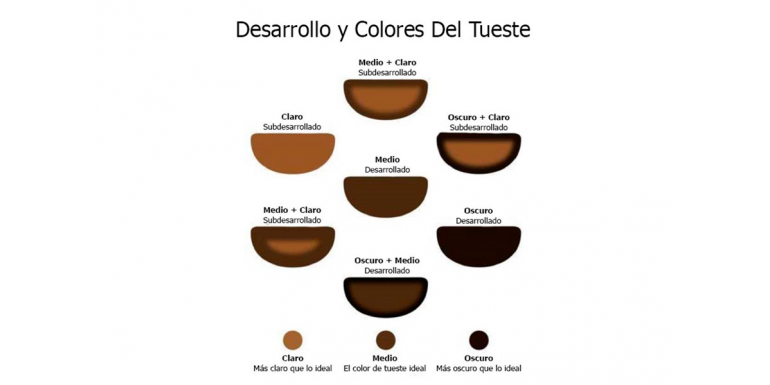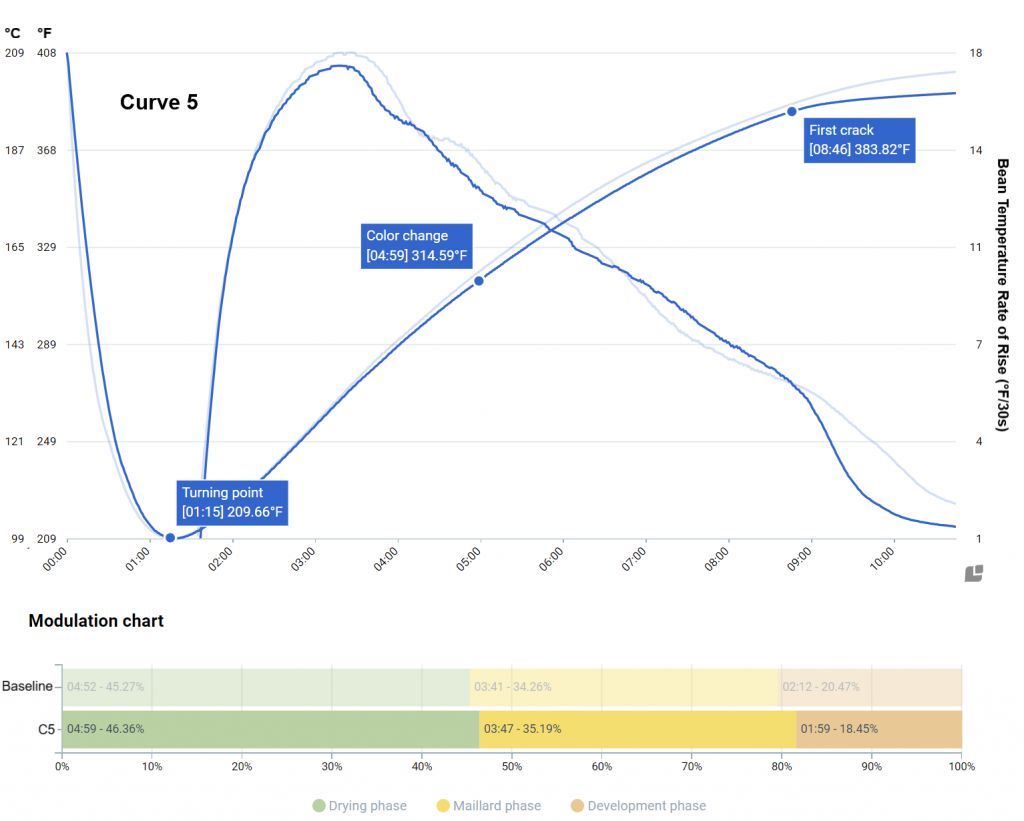The 3 phases and types of coffee roasting

Introduction to coffee roasting
The coffee beans we receive in the sacks from the different origins, also called "green coffee", have little to do with the coffee we see when we open the bag we have bought. As the name suggests, it is a rather greenish coffee, small and very hard. It is impossible to drink it.
In order to enjoy it, it has to be roasted, and in this "magical" process, physical and chemical changes take place in the bean, which turn coffee into the wonderful drink we desperately need every morning.
Much has been written about the changes that occur during the roasting process, and we have not wanted to be less, so if the reader is particularly interested, you will soon be able to enjoy the more technical sections in another article of the Blog, entitled "physical and chemical changes in coffee during the roasting process".
The time and temperature conditions in which coffee is roasted have a great influence on its final flavour. It is also essential to have a good knowledge of how the beans we roast develop and to be clear about our organoleptic objectives.
Although it is true that "every master has his own book", we are going to modestly approach the coffee roasting process in order to understand its dynamics, the changes that occur and how they affect us at the moment of the extraction of our favourite beverage.

The three stages of coffee roasting:
This section is written from the perspective of a coffee roaster. However, there is a growing trend in the USA to buy green coffee and roast it at home. So, who knows, you may be about to take your first steps as a roaster.
Roasting coffee is like cooking, say, a hamburger. The temperature of the pan, the intensity of the heat and the cooking time will determine our success. Of course, the density and thickness of what we cook, as well as our personal taste, will directly affect the way we cook it, so please do not take this explanation as an absolute and unalterable truth.
The most important thing is that the toaster is hot. By hot, we mean a temperature slightly above 200°C. If the temperature is much lower than this, the toaster may be too hot. If the temperature is much lower, we will probably suffer from underdeveloped beans and ruin our roasting. With temperatures slightly higher than this, we may be able to correct the roasting by applying less heat at later stages.
Once we have the right temperature, we introduce the green coffee beans. The heat is transferred to the beans, starting their expansion and chemical reactions (as shown in the graph, whose axes are temperature and time).
The first phase of coffee roasting: drying
This is Phase I: DRYING. There is an abrupt drop in temperature, of about 100 degrees, which occurs with the entry of the grains at room temperature and the initial loss of moisture from the grain. As the temperature rises, the drying process continues for approximately 5 minutes.
Only 2.5% water remains in the beans. During this time, acidity and body begin to develop.
The second phase of coffee roasting: the Maillard reaction
We enter phase II: THE MAILLARD REACTION. The temperature is around 150ºC. This is when the coffee bean begins to change its colour due to a reaction between the carbohydrates and amino acids in the bean. The expansion of the coffee cells also begins.
The coffee browns and through "Strecker degradation" the gases that will be responsible for the flavour and aroma start to be created. (If you liked this paragraph, I encourage you to read the Blog article entitled "physical and chemical changes in coffee during the roasting process".
The third phase of coffee roasting: development
And finally we come to phase III: DEVELOPMENT. This phase begins with "The first crack", which has nothing to do with economics or sport. It is named after the crackling noise that coffee makes, similar to popcorn. This crack occurs when the coffee beans expand and open due to the heat and pressure, releasing the steam and carbon dioxide trapped inside.
The approximate temperature is about 170ºC and the beans begin to turn a cinnamon colour, due to the roasting of the caramelised sugars, and the skins fall off the beans.
From this point on, the rate of roasting and the degree of development will determine the profile of the coffee, although it is important to be very careful, as chemical reactions occur very quickly at this point. The shorter the development time, the greater the sweetness and acidity; on the other hand, the longer the development time, the more caramelised the sugars become, giving rise to a greater bitterness and body.
At around 190º the "second crack" occurs, the coffee crackles again and finishes developing its aromas and gases.
As the coffee roasts to the second crack and beyond, its body increases and it becomes more bitter and smoky. It also begins to lose the recognisable characteristics of origin and acidity.
So it is essential to know which flavours you want to prioritise in your cup: if you want acidity, delicacy and to show more of the origin, choose a light roast. Similarly, if you want more bitterness and smoky flavours in your coffee, a dark roast will be more appropriate.
Once roasting is complete, the coffee is removed from the roaster and cooled so that it does not continue to roast.
Types of coffee roasting:
Depending on the level of detail we want to go into and the variables we analyse, we will be able to identify a wide variety of roasting types. In this case we will try to simplify and focus on coffee beans for home consumption.
Broadly speaking, we could define three roasting profiles: light (also known as "German style"), medium (or Spanish roast) and dark (also called "Italian style"). And as these things are very well said in English, we would be talking about Light, Medium & Dark roast, respectively. They are easily identified by the colour of the grain.
Light roast, also known as German-style roast:
What does the resulting roast look like? The resulting bean has a cinnamon colour, which is generally achieved by reducing roasting times. They use more heat during the process to reach the first crack more quickly (at a temperature of about 190ºC) and to be able to fix the natural acidity of the bean.
What is the coffee produced with this roast like? The result is a more aromatic, acidic, sweet and fruity cup, but it will lack some body and bitterness, which is achieved with a darker roast.
As the flavours of the origin are better preserved, this roast is widely used for speciality and gourmet coffees, and is particularly suitable for slow extraction methods, i.e. infusion after a long period of time.
It is characteristic of Northern European countries, where consumers have a preference for fruitier, smoother, longer filter coffees.
If you want to try it, go to our online shop and choose ORIGIN COFFEE: CERRADO LIGHT ROAST or your nearest Cafés Caracas coffee shop.
The medium roast, also known as Spanish-style roast, is a roast that is roasted in a medium roast:
What is the resulting roast like? Medium roasts are based on the principle that "there is virtue in the middle ground". They try to combine the goodness of light and dark roasts, without sacrificing anything.
They are generally roasted between the end of the first crack and the beginning of the second crack (between 210 °C and 220 °C). These will have a slightly muted acidity and will retain some of the characteristics of the origin of the coffee, but the roast flavour will also be noticeable, increasing the intensity and body of the roast compared to a light roast. With the increased heat exposure, the sugars will be more caramelised, bringing notes of nuts, caramel and, if we are lucky, chocolate.
What is the coffee produced with this roast like? This coffee is designed for all types of extractions (espresso, filter)... hence it is also called "omnitueste", as it is suitable for everything. It is the predominant roast here, which is why it is also known as "Spanish roast". This is a roast that simply seeks to bring out the best in coffee, no matter what the situation.
If you want to try it, go to our online shop and choose Mezcla coffees and other varieties of Origins are made this way.
Dark roast, also known as Italian-style roast:
What is the resulting roasting like? To achieve a dark roast, we have to reach at least the beginning of the second crack, which can be extended to halfway through the second crack (225 °C-240 °C). Coffee is not usually roasted beyond 250 °C, as it is at this point that the coffee will begin to have a charcoal or tarry flavour.
As the coffee is roasted to the second crack and beyond, its body increases and it becomes more bitter and smoky. It also begins to lose the recognisable characteristics of origin and acidity.
Through this roasting, more of the coffee's special oils are extracted, giving the final cup more bitterness and structure. However, we lose the sweetness and aroma that we used to get from light roasts.
What is the coffee produced with this roast like? It is a type of roast designed for extraction in an espresso machine (or espresso). Quick and concentrated extractions. These are very intense and full-bodied coffees. This is a very popular roast in Italy.
If you want to try it, go to our online shop and choose ORIGIN COFFEE: CERRADO DARK ROAST or your nearest Cafés Caracas coffee shop.
HOW WILL WE KNOW that the roasting is going wrong?
If roasting coffee sounded easy to you, I must have made a bad point, because it is not easy at all! Time management in the development phase is an art based on experience and influenced by many variables. Thus, we are exposed to deviations from our optimum, giving rise to the following problems:
- Underdevelopment usually occurs when a bean has not been roasted enough, or not roasted completely or when "the coffee is not roasted evenly throughout the bean (occurs with coffees roasted at high temperatures and with short roasting times). Visually it appears correct, but when tasted, some herbaceous or even undesirable notes are revealed.
- Overdevelopment, on the other hand, can include loss of acidity and subtle floral notes, excessive caramelisation and also the appearance of roasted flavours such as charcoal, toast and bitter chocolate.
- Baking occurs when insufficient heat is applied at some or all points of the roast, so that the coffee progresses too slowly.
Conclusion on types of roasting:
Consider what flavours you want in your cup: if you want acidity, delicacy and to show more of the origin, choose a light roast.
If you want more bitterness and smoky flavours in your coffee, a dark roast will be more appropriate.
It is possible to use both for filter or espresso; just remember that espresso is brewed with less water and therefore offers a more concentrated flavour and a heavier mouthfeel.
And remember, if you don't want to give up anything, medium (or "omnitueste") roast is for you.
Recent posts
-
Pacamara Nicaragua: Exploring the Coffee Treasures of Nicaragua 23/04/2024Cup of Excellence from a unique place in the world: the Apaneca-Ilamatepec volcanic mountain range 27/11/2023Safari through Ethiopia, a jewel called "Heirloom" 22/06/2023Discover the sensory experience of Brazilian Caracolillo Coffee 11/05/2023
Comments
Log in or register to post comments





